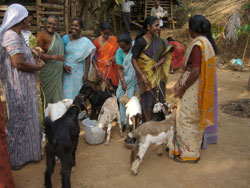 The practice of rearing goats, chicks or cattle in the backyard is centuries old. The village folk used to depend heavily on this practice for their daily bread and butter. Dwindling grazing lands and scarcity of green fodder were making cattle rearing - especially goat rearing, practiced on smaller household scale - very difficult in various parts of the country. Shrinking pasture lands and lack of green fodder are the major problems that keep away many farmers from rearing cattle, especially goats. In many parts of the country, the practice of rearing goats in the backyard is now a thing of past as it has become non profitable and highly expensive.
The practice of rearing goats, chicks or cattle in the backyard is centuries old. The village folk used to depend heavily on this practice for their daily bread and butter. Dwindling grazing lands and scarcity of green fodder were making cattle rearing - especially goat rearing, practiced on smaller household scale - very difficult in various parts of the country. Shrinking pasture lands and lack of green fodder are the major problems that keep away many farmers from rearing cattle, especially goats. In many parts of the country, the practice of rearing goats in the backyard is now a thing of past as it has become non profitable and highly expensive.
Pursuing timely endeavors and farmer friendly technologies through research, and answering to the very need of the farming community, the scientists at the Krishi Vigyan Kendra of Indian Institute of Spices Research (IISR), a constituent body of Indian Council of Agricultural Research, have come up with a unique idea.
‘Broiler Goat Rearing’, fine-tuned by the scientists of the Peruvannamuzhi Krishi Vigyan Kendra of IISR is a boon to the farming community especially in the areas where green fodder is in scarce.
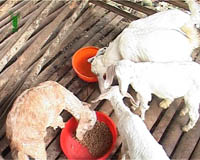
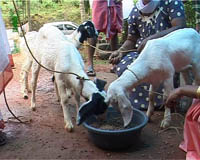

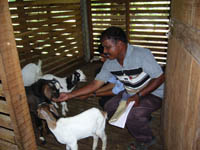
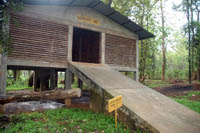
“After a long study, our scientists have fine tuned a new technology called broiler kid rearing where goat kids reared in sheds attain a better body weight and fetch remunerative income forfarmers. This method benefits landless labourers and small farmers,” says Dr. M. Anandaraj, Director IISR, Kozhikode.
Broiler rearing method is unique in itself. It is done by exploiting the high reproductive efficiency of female goats through proper planning and breeding, thus maintaining the quality of the offspring. At the same time to counter the scarcity of green fodder, a scientific and low cost feeding procedure is evolved.
s far as broiler goat rearing is concerned, there is no specific breed for this purpose. The kids (both male as well as female kids) of any local breeds can be selected and reared through this method.
Under this method, 15 to 30 days old kids with a higher birth weight are selected before they start eating green leaves. These kids, once identified, are kept away from their mothers and are housed separately in sheds made of bamboo or wooden poles. Proper ventilation, sunlight and cleanliness are ensured at all the times.
Initially, the kids are given small quantities of concentrated feed. And the quantity is increased gradually depending upon the intake. Additional supplements such as liver tonic mixed with fish oil are also given twice a week. Pure water is a must and should be provided in the shed round the clock. Young kids are also provided with mother’s milk for one month (twice or thrice a day) for their proper growth.
The goat feed will be available in the market or farmers can also prepare their own feed mix by using locally available ingredients like de-oiled ground nut cake, horse gram, wheat or maize, rice or wheat bran, etc.
For the healthy growth of the kids, the first de-worming should be done on the 45th day of rearing as broiler. The de-worming should be repeated every month, till the kids are sold.
Various women self help groups like Kaveri Kudumbashree and Nidhi and several other individual farmers in Peruvannamuzhi of Kozhikode district of Kerala have been rearing goats in this method for the past five years. According to the members of the group the method is highly suitable for those who don’t have enough land for grazing animals. For these landless women, this is a win-win proposition. The technology helps them to rear more number of goats in a very short span of time. Less cost, more profit, ease in cattle management, and a good demand for the goat meat are some of the many favourable factors encouraging the farming community to adopt broiler goat rearing more passionately.
Kids bred under broiler technology gain about 25-33 kilograms in 120-140 days, whereas in traditional system of green feeding, the goats acquire only a maximum weight of 10 kilos, that too in 6 months. The expenditure towards feeding a kid under this method comes to about Rs. 1200. A net income of Rs. 5050 to 7050 (at Rs. 250 per kg on live weight basis) can be easily realized.
“Now this has become a flagship programme of the Kendra. The success of this technology is not confined to Kerala alone. Farmers from other states like Karnataka, Tamil Nadu, Andhra Pradesh and Gujarat are visiting these Self Help Groups to witness their success formula. Recently we also received enquiries from overseas,” says Dr. T Arumughanathan, Programme Coordinator, KVK Peruvannamuzhi.
(Source: NAIP- Mass Media Project, DKMA with inputs from Consortium Partner, IISR, Kozhikode)








Like on Facebook
Subscribe on Youtube
Follow on X X
Like on instagram